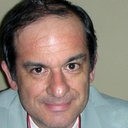Clinical quiz. Rubinstein-Taybi syndrome (synonyms: broad thumbs and great toes, characteristic facies, and mental retardation -- broad thumb-hallux syndrome).
Mots clés
Abstrait
A 28-year-old mentally retarded, institutionalised woman was referred to us for evaluation of multiple plantar warts and ingrown nails of both great toes. The patient was born to unrelated parents of North African origin and had one brother and three half-brothers, all of whom were healthy. Physical examination revealed short stature, slight obesity, facial abnormalities (Fig. 1), short and broad thumbs and big toes (Figs. 2 and 3). A keloid was found on the right forearm, that had developed after surgical correction of a fracture (Fig. 4). Ill-defined hyperpigmented macules were observed on the trunk. The patient also presented pruritic eczematous lesions of the limbs and the back that had been present for some years and were recurrent despite treatment with emollients and local steroids. Androgenetic-type alopecia of moderate severity was seen on the vertex of the scalp. Past medical history included polydactylism of the feet and clinodactyly of the thumbs (both corrected surgically), respiratory tract infections, Wolf-Parkinson-White syndrome and refractive errors necessitating glasses.


